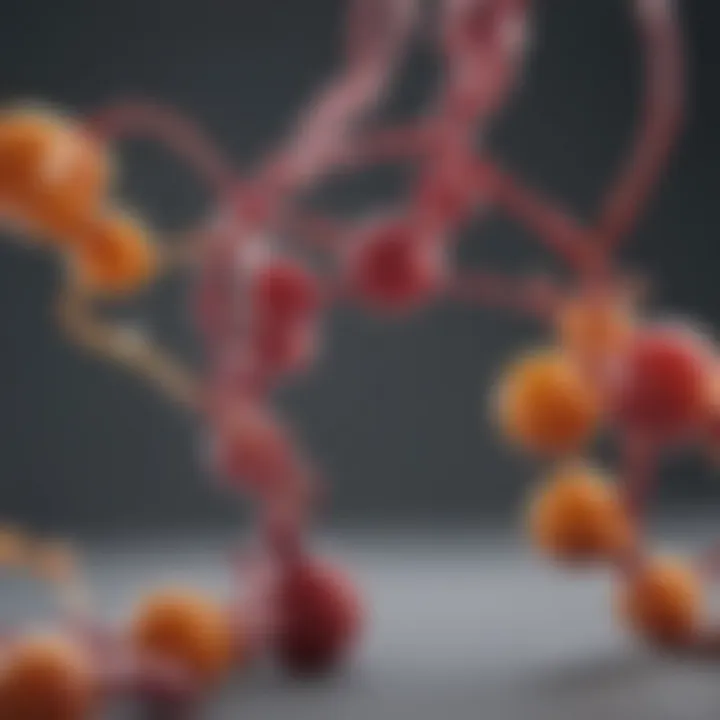Fructose and Gout: Implications and Mechanisms


Intro
The interconnection between diet and metabolic disorders is a crucial area of study in nutrition science. One such condition that has raised significant concern is gout, a type of arthritis characterized by intense pain and inflammation in the joints. An important dietary component linked to the onset and exacerbation of gout is fructose. This natural sugar, commonly found in many fruits and processed foods, has garnered attention due to its unique metabolic pathway.
Understanding how fructose affects urate levels can illuminate its role in gout development. This overview aims to present a structured analysis of the biochemical processes involved. Gout itself results from elevated levels of uric acid, a waste product formed from purines in the body. When fructose is metabolized, it can lead to increased uric acid production. Given the rising levels of fructose in modern diets, assessing its implications for gout becomes increasingly relevant.
In the subsequent sections, the article will delve deeper into the mechanisms through which fructose influences urate levels, explore dietary sources of fructose, and evaluate the prevalence of gout in populations with high fructose intake. The journey toward managing fructose intake effectively for the prevention and treatment of gout will also be discussed.
Prologue to Fructose
Understanding fructose is vital in comprehending its implications for health, particularly regarding metabolic disorders such as gout. Fructose is a simple sugar that occurs naturally in many foods, especially fruits. While it is a part of a balanced diet, excessive intake can lead to significant health issues. Gout, a form of inflammatory arthritis characterized by painful flare-ups, has been strongly associated with high fructose consumption. This section serves as an entry point into the complex relationship between fructose and gout.
Fructose has unique biochemical pathways that distinguish it from other sugars, especially in how the body metabolizes it. The impact of fructose on uric acid levels cannot be overstated, as elevated uric acid can precipitate gout attacks. Recognizing the chemical structure of fructose and its dietary sources is critical for those seeking to manage or prevent gout. Understanding these elements provides insight into how dietary choices affect overall health and contributes to a larger narrative about nutrition and disease prevention.
Moreover, knowledge of fructose's metabolism in the body reveals its more nuanced role in metabolic health. As this narrative unfolds, we will explore the mechanisms by which fructose influences uric acid production and how that connects back to gout.
Chemical Structure and Sources
Fructose is a monosaccharide, which means it is one of the simplest forms of carbohydrates. Its chemical formula is C62O6, and it has a structural form known as a ketose, distinguishing it from glucose. Structurally, fructose is often found alongside glucose in sucrose, common table sugar.
Natural sources of fructose are abundant. Fruits such as apples, pears, and berries, along with honey, provide fructose in a healthful form that is often accompanied by fiber and essential nutrients. However, processed sources, primarily high-fructose corn syrup (HFCS), have become prevalent in many diets. This syrup, commonly found in soft drinks and processed foods, can contribute to heightened fructose intake without the benefits of whole foods. Recognizing these sources is important for understanding dietary patterns.
- Natural Sources:
- Processed Sources:
- Fruits: Apples, Pears, Berries
- Honey
- High-Fructose Corn Syrup
- Sweetened Beverages
Metabolism of Fructose in the Body
The body metabolizes fructose differently from glucose. Primarily, fructose is processed in the liver, where it can lead to increased levels of uric acid, a byproduct of this metabolic pathway. Unlike glucose, which stimulates insulin secretion, fructose does not trigger a significant release of insulin, which can lead to unregulated energy storage and may exacerbate the risk of developing insulin resistance.
When fructose is consumed in excess, the liver converts it into fatty acids through a process called de novo lipogenesis. This can contribute to non-alcoholic fatty liver disease and result in increased uric acid production. Consequently, it is crucial for individuals, especially those predisposed to gout, to monitor their fructose intake to mitigate these risks.
"The metabolism of fructose has profound implications on metabolic health, especially concerning uric acid levels and the potential for developing gout."
In summary, understanding both the chemical structure of fructose and its metabolism illuminates the pathway to recognizing its health implications. The exploration of how fructose impacts uric acid production will lay the groundwork for understanding gout in the following sections.
Understanding Gout
Understanding gout is essential for appreciating the intricate relationship it has with fructose consumption. Gout is a type of inflammatory arthritis characterized by sudden, severe attacks of pain, swelling, and redness in the joints. It occurs when uric acid crystals accumulate in the joints, leading to inflammation. Knowledge of gout helps in recognizing triggers, symptoms, and effective management strategies.
The connection between fructose and gout is especially critical due to the former's impact on uric acid levels. High fructose intake can raise uric acid concentrations, increasing the likelihood of gout attacks. Given the modern diet often rich in fructose, comprehending how dietary choices affect gout risk becomes increasingly important. Furthermore, understanding gout allows individuals to engage more proactively in their health management, potentially preventing the painful episodes associated with the condition.
Definition and Pathophysiology of Gout
Gout is defined as a form of arthritis that arises from elevated levels of uric acid in the bloodstream, a condition known as hyperuricemia. When uric acid levels exceed the solubility threshold, monosodium urate crystals form and deposit in the joints and surrounding tissues. The immune system responds to these crystals, leading to inflammation and an intense pain response.
The pathophysiology of gout includes several key components:
- Formation of urate crystals
- Inflammatory response triggered by the immune system
- Episodes of acute pain, as well as chronic joint damage over time
Identifying the specific mechanisms underlying gout can help in devising targeted treatments and diet modifications, particularly concerning fructose and other dietary influences.


Symptoms and Diagnosis
Gout typically presents with sudden and severe symptoms, manifesting primarily in the joints. Common symptoms include:
- Intense pain, particularly in the big toe
- Swelling and redness around affected joints
- Warmth in the area of inflammation
- Limited range of motion during flare-ups
Diagnosis of gout often involves a combination of clinical evaluation and laboratory tests. The following methods are commonly used in diagnosing gout:
- Joint fluid analysis to identify urate crystals
- Blood tests to measure uric acid levels
- Imaging studies, such as ultrasound or X-ray, to assess joint damage and inflammation
Understanding these symptoms and diagnostic approaches is crucial for early detection and effective management of gout, particularly in individuals with dietary risk factors, such as high fructose intake.
Fructose's Role in Metabolic Processes
Fructose plays a significant role in various metabolic processes, particularly in how it affects uric acid levels and insulin sensitivity. Understanding these connections is crucial given the growing concerns surrounding fructose consumption and its implications for conditions like gout. This article will detail how fructose metabolism can lead to increased uric acid levels, thus potentially triggering gout attacks. Furthermore, it will explore how excessive fructose intake is linked to insulin resistance, which can compound metabolic disturbances.
Uric Acid Production
Mechanism of Uric Acid Formation
The metabolism of fructose contributes to the formation of uric acid through a series of biochemical reactions. Once ingested, fructose is phosphorylated by fructokinase, leading to the production of fructose-1-phosphate. This pathway utilizes adenosine triphosphate (ATP) rapidly, which ultimately reduces the energy available in the cell. The increased turnover of purine nucleotides results in their breakdown to uric acid.
One of the key characteristics of this mechanism is how swiftly fructose is metabolized. Unlike glucose, fructose bypasses the key regulatory step in glycolysis, which allows it to enter the metabolic pathway unimpeded. This rapid metabolism makes fructose particularly potent in elevating uric acid levels.
An important advantage of understanding this mechanism is its direct link to gout pathophysiology. Higher levels of uric acid lead to crystallization in the joints, causing intense pain and inflammation. Identifying the process can aid in developing interventions or dietary changes to mitigate these risks. However, it is fundamental to consider that not all individuals will respond similarly to fructose intake, as genetic and environmental factors play a role.
Impact of Fructose on Uric Acid Levels
Fructose significantly impacts uric acid levels, particularly in the context of a high-fructose diet. Studies indicate that increased consumption of fructose leads to a rise in uric acid concentration in the bloodstream. As previously mentioned, the efficient conversion of fructose to uric acid contributes to this effect.
The increased uric acid levels can have profound health implications, making the exploration of this impact vital for understanding gout and related conditions. One notable feature is the dose-dependent nature of fructose; small amounts might have a negligible effect, but excessive consumption, especially from processed sources like high-fructose corn syrup, can lead to heightened risks of gout.
One advantage of analyzing this impact is the potential for preventive strategies. Individuals aware of fructose's influence on uric acid can make informed dietary choices to limit exposure to high-fructose foods and drinks.
Fructose and Insulin Resistance
The relationship between fructose consumption and insulin resistance is complex. High intake of fructose is associated with an increase in insulin resistance, a condition that can precede the development of Type 2 diabetes and other metabolic disorders. When the liver processes fructose, it can lead to excessive fat formation, contributing to fatty liver disease and metabolic syndrome.
One of the critical aspects of this relationship is that while glucose regulates insulin secretion, fructose does not stimulate insulin release in the same way. This may lead to a more significant energy imbalance because individuals might not feel a sense of fullness despite consuming calories.
Understanding how fructose interacts with insulin can deliver important insights into metabolic health. By recognizing fructose as a potential contributor to insulin resistance, medical professionals and patients alike can adopt better dietary practices.
In summary, the role of fructose in metabolic processes underscores its influence on both uric acid production and insulin resistance. This connection is not merely academic; it has real-world implications for managing gout and other chronic conditions linked to dietary choices. Thus, exploring fructose’s metabolic pathways may be pivotal in alleviating the burden of diseases associated with overconsumption.
Epidemiological Studies on Fructose Intake and Gout
Epidemiological studies play a vital role in understanding the connection between fructose intake and gout. These studies provide insight into patterns of disease occurrence in specific populations. They draw correlations between dietary habits and the incidence of gout, helping researchers identify potential cause-and-effect relationships. Unraveling these associations can aid in establishing preventive measures and dietary guidelines for those at risk.
By analyzing large groups of individuals, researchers can assess how variations in fructose consumption influence gout prevalence. This analysis helps illuminate broader health implications and suggests possible mechanisms through which fructose impacts uric acid levels, exacerbating gout symptoms.
Prevalence of Gout in Populations with High Fructose Consumption
There is a noticeable trend concerning the prevalence of gout within populations that consume high quantities of fructose. Several studies show that these groups experience higher incidence rates of gout compared to those with lower fructose intake. This can often be attributed to the metabolic processes that fructose undergoes, leading to increased production of uric acid.
For instance, one extensive study in the United States indicated that individuals with high fructose consumption, particularly from sweetened beverages, presented higher uric acid levels and a greater tendency to experience gout attacks. This suggests that fructose may serve as a significant dietary risk factor.


Comparative Analysis of Diets
To better understand the implications of fructose on gout, it is essential to compare diets with varying levels of this sugar.
Diets High in Fructose
Diets high in fructose are characterized by significant intake of processed foods, sweetened beverages, and fruit juices. The primary contributor to this diet is high-fructose corn syrup, which has become a prevalent sweetener in many products. The unique feature of these diets lies in their ability to rapidly elevate blood sugar levels, triggering an increase in insulin insulin response. This response, in combination with fructose metabolism, leads to higher uric acid production.
However, while these diets are often associated with energy-rich foods, their disadvantage is the potential for metabolic disturbances, including conditions like obesity and insulin resistance, which further amplify the risk of developing gout.
Diets Low in Fructose
Conversely, diets low in fructose emphasize whole foods, vegetables, and lean proteins while limiting added sugars. The key characteristic of these diets is their focus on natural food sources, promoting better overall health and maintaining a lower uric acid level. Foods such as whole grains, nuts, and low-fat dairy are staples in this dietary pattern.
This dietary approach is beneficial as it not only reduces the incidence of gout flares but also supports overall metabolic health. The unique feature here is the emphasis on balanced nutrition, which can mitigate the effects of excess fructose and enhance the body’s ability to regulate uric acid.
These comparative analyses shed light on how dietary patterns can significantly influence the risk of gout, providing valuable insight for both patients and health practitioners.
Dietary Sources of Fructose
Understanding dietary sources of fructose is critical in the discussion of fructose and gout. Fructose is a type of simple sugar found in various foods. Its sources can be both natural and processed, which influences how much fructose individuals may consume daily. Knowledge of these sources aids in guiding dietary choices; it's essential for those concerned about gout or maintaining healthy uric acid levels.
Natural Sources of Fructose
Natural sources of fructose are generally considered healthy and digestible. They provide essential nutrients along with sugar, making their consumption beneficial in moderate amounts.
Fruits and Fruit Juices
Fruits and fruit juices are abundant sources of fructose. Common varieties like apples, pears, grapes, and watermelon contain higher levels of this sugar. These foods are rich in vitamins and fiber, crucial for maintaining overall health. Importantly, the high water content in fruits helps dilute sugars, reducing their immediate impact on blood sugar levels.
Key characteristics of fruits include their natural antioxidant properties, which enhance metabolic functions. For those interested in managing fructose intake while enjoying sweet flavors, whole fruits present a sensible choice. However, fruit juices may lack fiber and can lead to higher fructose consumption if consumed in large volumes. Thus, moderation is key when incorporating fruit juices into the diet.
Honey
Honey is another natural source of fructose that many people enjoy. It is composed of about 40% fructose, providing a sweet option that some might prefer over processed sugars. One of the key characteristics of honey is its distinct flavor and versatility as a sweetener in various dishes.
Its unique feature lies in its various microbial properties and potential health benefits, such as soothing sore throats and aiding digestion. However, like other sources of fructose, honey should be consumed cautiously. Excessive intake can contribute to elevated uric acid levels, indirectly exacerbating gout symptoms.
Processed Sources of Fructose
Processed sources of fructose are prevalent in modern diets and require careful consideration. They often lack the nutrients found in natural sources, making them less beneficial.
High-Fructose Corn Syrup
High-fructose corn syrup is widely used as a sweetening agent in processed foods. It contains roughly the same amount of fructose as sucrose, making it a common concern for those monitoring their sugar intake. The key characteristic of high-fructose corn syrup is its effectiveness in enhancing sweetness at a lower cost for manufacturers. Existing in many popular snacks and fast food items, it has become a staple in the American diet.
The unique feature of high-fructose corn syrup is its wide availability and convenience. While it can improve taste and shelf life, its health implications are significant. Studies indicate a correlation between high-fructose corn syrup consumption and increased risks of obesity and metabolic disorders, thus affecting uric acid production and gout risk.
Sweetened Beverages
Sweetened beverages, including sodas and flavored drinks, often contain high levels of fructose, particularly when sweetened with high-fructose corn syrup. These drinks are appealing due to their flavor and accessibility. However, they contribute to a rapid intake of sugars without the nutritional benefits found in whole foods.
A critical characteristic of sweetened beverages is their high calorie content with minimal nutritional value. Frequently consuming these drinks can lead to weight gain and increased uric acid production. The unique downside is that sweetened beverages provide no satiety, potentially leading to overconsumption of calories and sugars. This can harm those predisposed to gout.


In summary, dietary sources of fructose consist of both natural and processed options. Each source presents unique attributes and considerations that should be evaluated, especially in the context of gout management. Awareness of these sources can empower individuals to make informed dietary choices that may mitigate gout flare-ups and promote overall health.
Mechanisms Linking Fructose to Gout Flare-ups
Understanding the connection between fructose intake and gout flare-ups is crucial. Gout, characterized by painful inflammation, results from the accumulation of uric acid in the bloodstream. The metabolism of fructose plays a significant role in elevating uric acid levels. Recognizing how these mechanisms work can inform dietary decisions and management strategies for individuals concerned about gout.
Role of Fructose in Purine Metabolism
Fructose influences purine metabolism significantly. The liver metabolizes fructose through a series of enzymatic reactions, which result in the production of uric acid. When fructose is ingested, enzymes like fructokinase rapidly convert it into intermediates. These intermediates eventually lead to an increase in AMP (adenosine monophosphate) levels. Elevated AMP levels get converted to uric acid. Therefore, higher fructose consumption can create a direct pathway for increased uric acid production, contributing to the risk of gout flare-ups.
Additionally, the high rates at which fructose is metabolized can overwhelm the body's ability to adequately dispose of uric acid. This imbalance can lead to the saturation of uric acid in the blood, increasing the likelihood of crystal formation in joints and tissues. This mechanism underscores the need for awareness regarding fructose intake among individuals prone to gout.
Impact on Kidneys and Uric Acid Excretion
The kidneys play a central role in the excretion of uric acid. Fructose's impact on kidney function is an important aspect to consider. When uric acid levels in the blood rise due to excessive fructose consumption, the kidneys may struggle to filter out the excess uric acid.
Research indicates that fructose may impair renal excretion of uric acid. This impairment can lead to an accumulation of uric acid over time. Subsequently, less uric acid is eliminated from the body, which can exacerbate conditions like gout.
In summary, fructose not only directly enhances uric acid production but can also impact the body's ability to excrete it effectively. Understanding these mechanisms offers valuable insight into dietary management for gout.
"Restricting fructose intake can be an effective strategy in managing uric acid levels and preventing gout flare-ups."
Preventive Measures Against Gout
Gout is a complex condition that results from elevated uric acid levels in the blood. Managing this condition often requires more than just medication; it necessitates lifestyle and dietary interventions. Preventive measures against gout are crucial not only for those already experiencing gout attacks but also for individuals aiming to avoid future occurrences. An effective strategy involves minimizing fructose intake, which has a direct correlation with uric acid production. Furthermore, a well-rounded diet plays a significant role in maintaining overall health and preventing gout flare-ups.
Strategies for Reducing Fructose Intake
Reducing fructose intake is a primary strategy in the prevention of gout. Fructose contributes to increased levels of uric acid, which can precipitate gout symptoms. Here are several actionable strategies that can help in minimizing fructose consumption:
- Avoid sugary drinks: Beverages such as soda and sweetened juices often contain high-fructose corn syrup, a significant source of dietary fructose. Opting for water or unsweetened drinks can significantly lower fructose intake.
- Limit processed foods: Many processed foods contain hidden sugars, including fructose. Reading labels is essential to identify these hidden sources.
- Choose natural sweeteners wisely: While honey and agave syrup may be perceived as healthier options, they still contain fructose and should be used sparingly.
- Increase fruit awareness: While fruits are healthful, some have higher fructose levels than others. Limiting consumption of high-fructose fruits like apples and pears while enjoying lower fructose options can help.
These strategies can help in effectively managing fructose consumption and mitigating its impact on uric acid levels.
Importance of a Balanced Diet
A balanced diet is fundamental in preventing gout and managing its symptoms. The inclusion of a variety of nutrient-dense foods can contribute to overall health and assist the body in dealing with uric acid. Here are some key points about the importance of a balanced diet:
- Rich in vegetables and whole grains: These foods provide fiber and essential nutrients while helping to maintain a healthy weight, which is crucial for gout management.
- Lean protein sources: Opting for lean meats and plant-based proteins can help reduce the risk of gout attacks. Foods such as chicken, fish, and legumes are excellent choices.
- Limit purine-rich foods: Foods such as red meat and certain seafood can elevate uric acid levels. It is beneficial to limit these in the diet.
- Adequate hydration: Drinking sufficient water helps in uric acid excretion and can prevent crystal formation in joints.
- Moderate alcohol intake: Alcohol, especially beer, should be consumed in moderation due to its potential to raise uric acid levels.
A balanced diet not only supports joint health but can also reduce the risk factors associated with gout.
Epilogue
The examination of fructose's role in the context of gout emphasizes how dietary choices can profoundly affect health. Understanding the connection between fructose consumption and gout can lead to better management strategies for those at risk. Moreover, this knowledge serves as a reminder that what we eat can have significant consequences on our bodily functions.
Summary of Fructose's Impacts on Gout
In summary, fructose is intricately linked to the development of gout. The ingestion of fructose elevates uric acid levels in the body, leading to its accumulation and subsequent crystal formation in joints, which triggers gout attacks. This connection elucidates the biochemical pathways involved. The metabolism of fructose, particularly through fructolysis, is a key player in this process, influencing uric acid production directly.
Key points regarding fructose's impacts include:
- Increased Uric Acid Production: Fructose consumption significantly raises urate levels due to the unique metabolic pathways it undergoes.
- Epidemiological Evidence: Higher fructose intake correlates with increased prevalence of gout in various populations, underlining the need for dietary considerations.
- Dietary Sources: Awareness of dietary sources rich in fructose is paramount for managing intake, promoting informed choices.
"Understanding how fructose relates to gout provides crucial insights for prevention and treatment strategies."
Future Research Directions
As research evolves, several directions merit attention regarding fructose and gout. Primarily, more extensive and longitudinal studies are necessary to clarify the relationship between specific fructose quantities and gout incidence. Additionally, investigating the metabolic pathways can reveal further genetic or environmental factors that influence individual susceptibility to the effects of fructose.
Furthermore, the role of other dietary components in conjunction with fructose intake could yield insights into more holistic management strategies for gout. Exploring the interactions between fructose and different nutrients will be essential in shaping dietary recommendations tailored for gout management. This could lead to the development of comprehensive dietary guidelines and potential therapeutic approaches.







